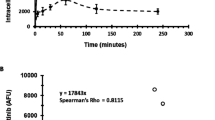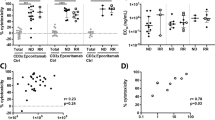Abstract
Gemtuzumab ozogamicin (Mylotarg®) induces remission in approximately 30% of relapsed AML patients. We previously demonstrated that gemtuzumab infusion results in near-complete CD33 saturation in peripheral blood, and that saturating gemtuzumab levels result in continuous binding and internalization of gemtuzumab due to renewed CD33 expression. We now demonstrate that a high CD33-antigen load in peripheral blood is an independent adverse prognostic factor, likely due to peripheral consumption of gemtuzumab. Indeed, CD33 saturation in bone marrow is significantly reduced (40–90% saturation) as compared with CD33 saturation in corresponding peripheral blood samples (>90%). In vitro, such reduced CD33 saturation levels were strongly related with reduced cell kill. Apparently, high CD33-antigen loads in blood consume gemtuzumab and thereby limit its penetration into bone marrow. Consequently, CD33 saturation in bone marrow is reduced, which hampers efficient cell kill. Therefore, gemtuzumab should be administered at higher or repeated doses, or, preferably, after reduction of the leukemic cell burden by classical chemotherapy.
This is a preview of subscription content, access via your institution
Access options
Subscribe to this journal
Receive 12 print issues and online access
$259.00 per year
only $21.58 per issue
Buy this article
- Purchase on Springer Link
- Instant access to full article PDF
Prices may be subject to local taxes which are calculated during checkout



Similar content being viewed by others
References
Hamann PR, Hinman LM, Hollander I, Beyer CF, Lindh D, Holcomb R et al. Gemtuzumab ozogamicin, a potent and selective anti-CD33 antibody-calicheamicin conjugate for treatment of acute myeloid leukemia. Bioconjug Chem 2002; 13: 47–58.
Larson RA, Boogaerts M, Estey E, Karanes C, Stadtmauer EA, Sievers EL et al. Antibody-targeted chemotherapy of older patients with acute myeloid leukemia in first relapse using Mylotarg (gemtuzumab ozogamicin). Leukemia 2002; 16: 1627–1636.
Sievers EL, Larson RA, Stadtmauer EA, Estey E, Lowenberg B, Dombret H et al. Efficacy and safety of gemtuzumab ozogamicin in patients with CD33-positive acute myeloid leukemia in first relapse. J Clin Oncol 2001; 19: 3244–3254.
Giles FJ, Kantarjian HM, Kornblau SM, Thomas DA, Garcia-Manero G, Waddelow TA et al. Mylotarg (gemtuzumab ozogamicin) therapy is associated with hepatic venoocclusive disease in patients who have not received stem cell transplantation. Cancer 2001; 92: 406–413.
Bross PF, Beitz J, Chen G, Chen XH, Duffy E, Kieffer L et al. Approval summary: gemtuzumab ozogamicin in relapsed acute myeloid leukemia. Clin Cancer Res 2001; 7: 1490–1496.
van der Velden VHJ, te Marvelde JG, Hoogeveen PG, Bernstein ID, Houtsmuller AB, Berger MS et al. Targeting of the CD33-calicheamicin immunoconjugate Mylotarg (CMA-676) in acute myeloid leukemia: in vivo and in vitro saturation and internalization by leukemic and normal myeloid cells. Blood 2001; 97: 3197–3204.
Jedema I, Barge RMY, van der Velden VHJ, Nijmeijer BA, te Marvelde JG, van Dongen JJM et al. Internalization and cell cycle dependent killing of leukemic cells by gemtuzumab ozogamicin (GO): rationale for application in CD33 negative malignancies with endocytic capacity. Leukemia 2004; 18: 316–325.
Jedema I, Barge RM, Willemze R, Falkenburg JH . High susceptibility of human leukemic cells to Fas-induced apoptosis is restricted to G(1) phase of the cell cycle and can be increased by interferon treatment. Leukemia 2003; 17: 576–584.
van der Velden VHJ, Berger MS, van Dongen JJM . Mylotarg therapy in acute myeloid leukemia: mechanism of action and implications for future treatment protocols. Haematol Blood Transfusion 2003; 41: 169–176.
Giles F, Estey E, O'Brien S . Gemtuzumab ozogamicin in the treatment of acute myeloid leukemia. Cancer 2003; 98: 2095–2104.
Alvarado Y, Tsimberidou A, Kantarjian H, Cortes J, Garcia-Manero G, Faderl S et al. Pilot study of Mylotarg, idarubicin and cytarabine combination regimen in patients with primary resistant or relapsed acute myeloid leukemia. Cancer Chemother Pharmacol 2003; 51: 87–90.
Kell WJ, Burnett AK, Chopra R, Yin JA, Clark RE, Rohatiner A et al. A feasibility study of simultaneous administration of gemtuzumab ozogamicin with intensive chemotherapy in induction and consolidation in younger patients with acute myeloid leukemia. Blood 2003; 102: 4277–4283.
Tsimberidou A, Cortes J, Thomas D, Garcia-Manero G, Verstovsek S, Faderl S et al. Gemtuzumab ozogamicin, fludarabine, cytarabine and cyclosporine combination regimen in patients with CD33+ primary resistant or relapsed acute myeloid leukemia. Leuk Res 2003; 27: 893–897.
Tsimberidou A, Estey E, Cortes J, Thomas D, Faderl S, Verstovsek S et al. Gemtuzumab, fludarabine, cytarabine, and cyclosporine in patients with newly diagnosed acute myelogenous leukemia or high-risk myelodysplastic syndromes. Cancer 2003; 97: 1481–1487.
Apostolidou E, Cortes J, Tsimberidou A, Estey E, Kantarjian H, Giles FJ . Pilot study of gemtuzumab ozogamicin, liposomal daunorubicin, cytarabine and cyclosporine regimen in patients with refractory acute myelogenous leukemia. Leuk Res 2003; 27: 887–891.
Tsimberidou AM, Estey E, Cortes JE, Garcia-Manero G, Faderl S, Verstovsek S et al. Mylotarg, fludarabine, cytarabine (ara-C), and cyclosporine (MFAC) regimen as post-remission therapy in acute myelogenous leukemia. Cancer Chemother Pharmacol 2003; 52: 449–452.
Linenberger ML, Hong T, Flowers D, Sievers EL, Gooley TA, Bennett JM et al. Multidrug-resistance phenotype and clinical responses to gemtuzumab ozogamicin. Blood 2001; 98: 988–994.
Walter RB, Raden BW, Hong TC, Flowers DA, Bernstein ID, Linenberger ML . Multidrug resistance protein attenuates gemtuzumab ozogamicin-induced cytotoxicity in acute myeloid leukemia cells. Blood 2003; 102: 1466–1473.
Acknowledgements
We thank Marieke Comans-Bitter for preparation of the figures, Mark Berger, Mat Sherman, Cathy Eten, Gerry Messerschmidt, and Chantal Lejeune for support with the gemtuzumab protocols 0903B1-202-EU and 0903B1-203-EU, Philipp Hamann for helpful discussions, Dr WCJ Hop for help with statistical analyses, and Dr Ton Langerak, Dr Mirjam van der Burg, and Dr Jon Laman for critical reading of the manuscript.
Author information
Authors and Affiliations
Rights and permissions
About this article
Cite this article
van der Velden, V., Boeckx, N., Jedema, I. et al. High CD33-antigen loads in peripheral blood limit the efficacy of gemtuzumab ozogamicin (Mylotarg®) treatment in acute myeloid leukemia patients. Leukemia 18, 983–988 (2004). https://doi.org/10.1038/sj.leu.2403350
Received:
Accepted:
Published:
Issue Date:
DOI: https://doi.org/10.1038/sj.leu.2403350



